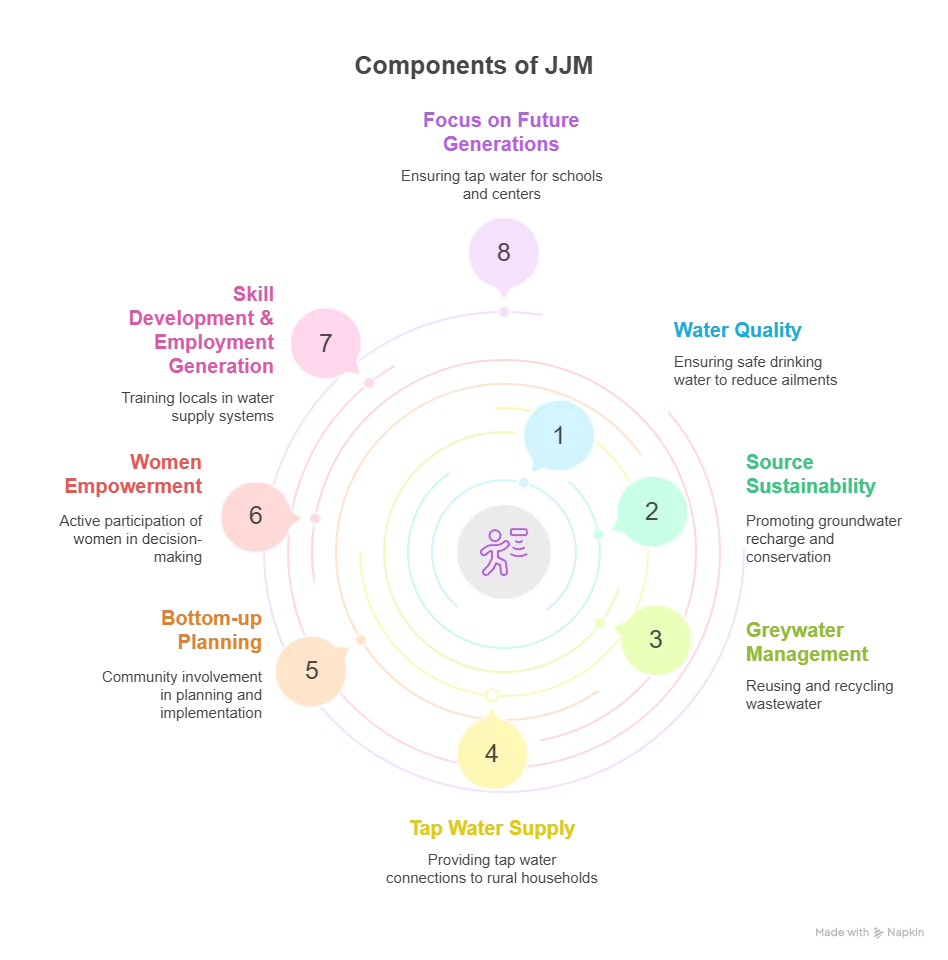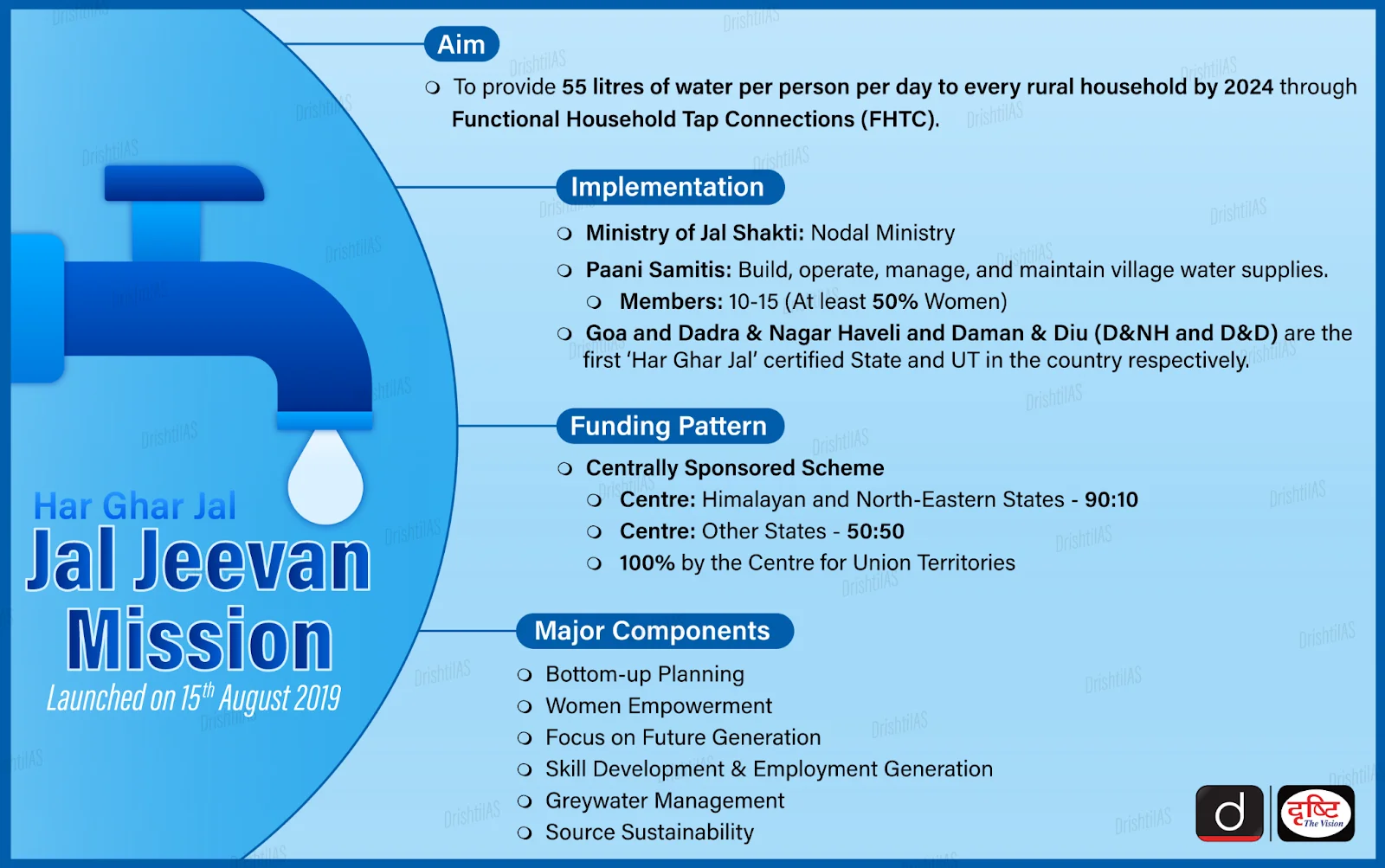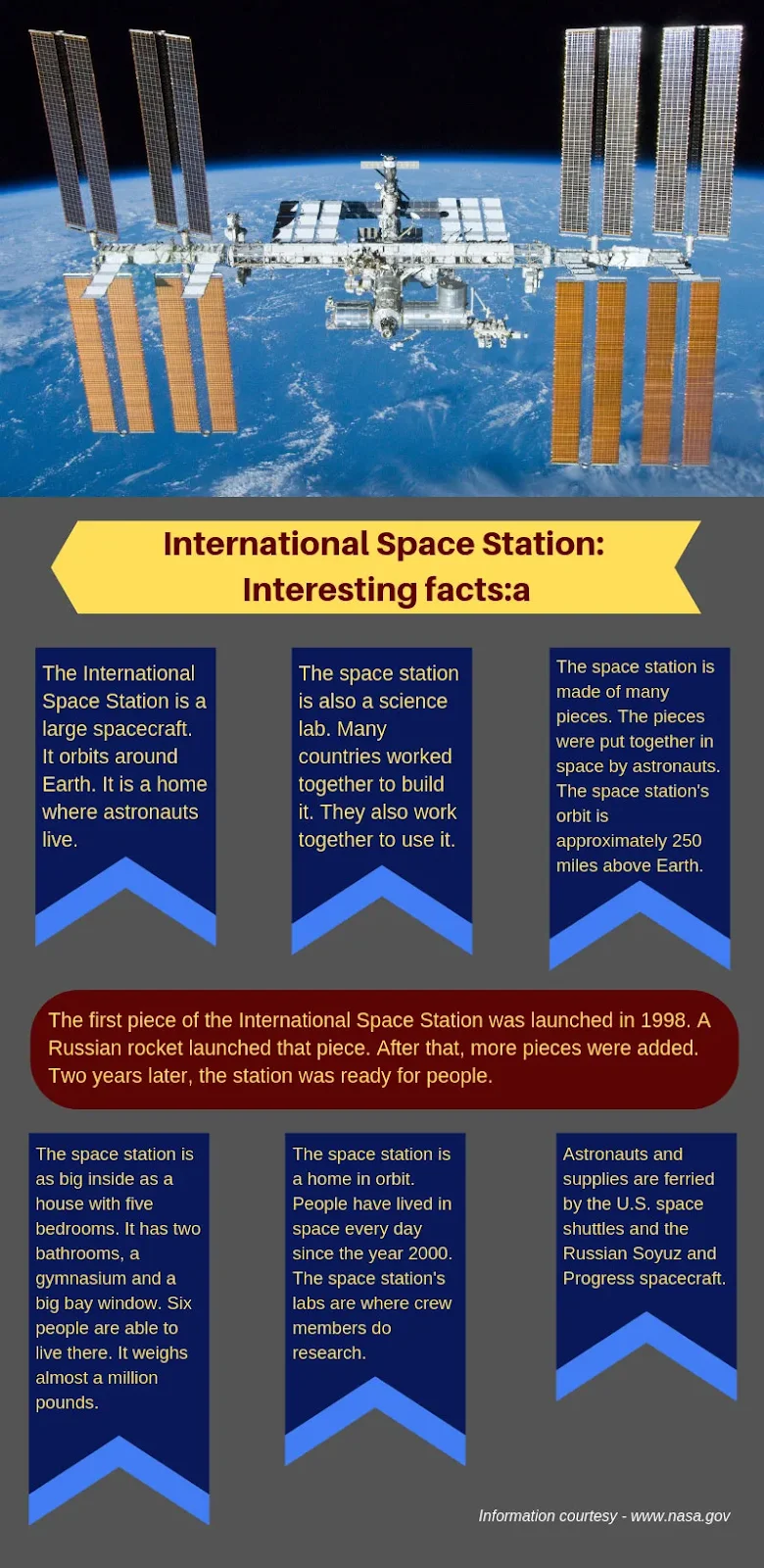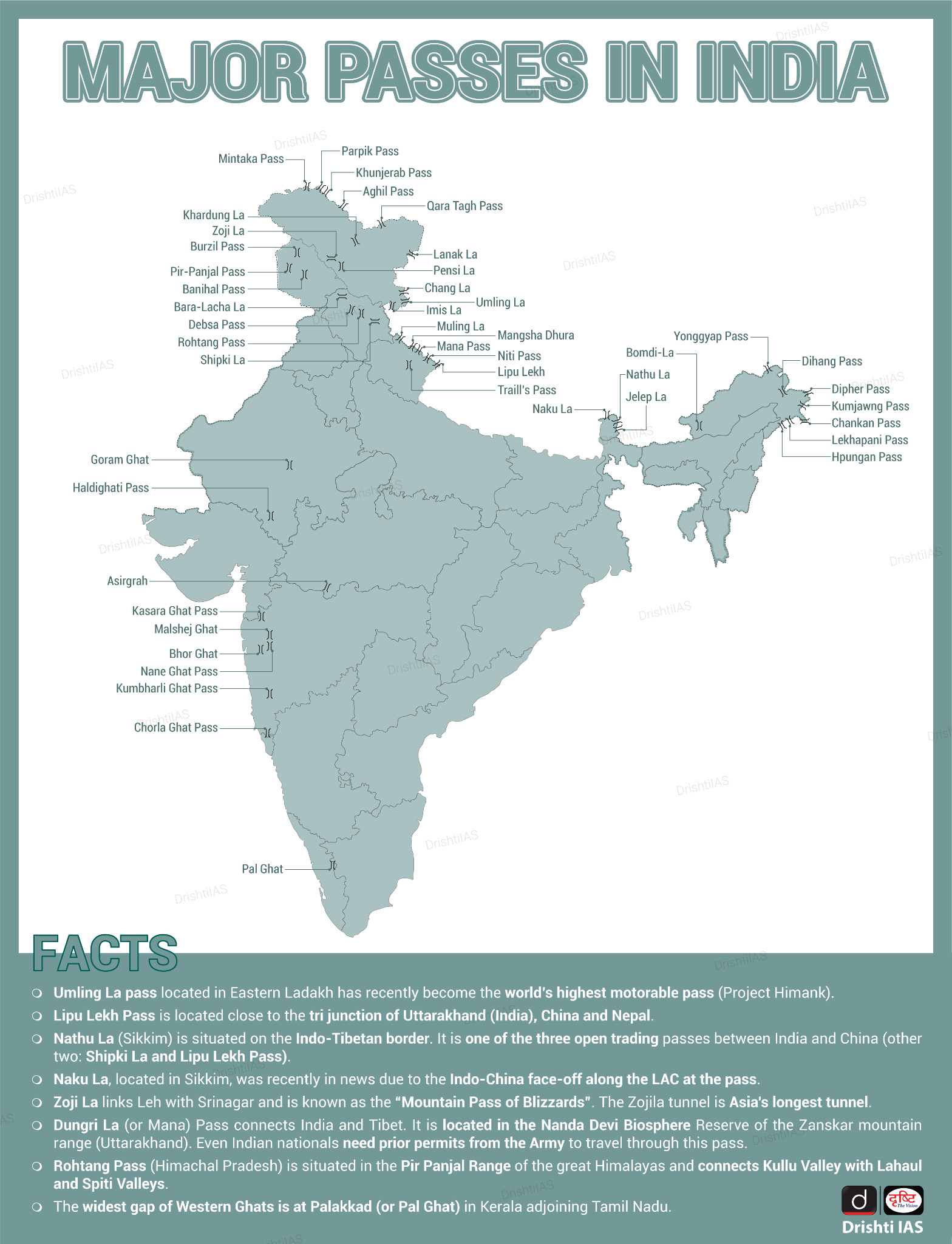Charting a New Course in India China Relations
For Prelims: China+1 strategy, 2023-24 Economic Survey, PM-DevINE, BIMSTEC, IN-SPACe, India Semiconductor Mission
For Mains: India-China Bilateral Relations, Cooperation and Disputes.
Why in News?
The External Affairs Minister of India held a ministerial-level meeting with the Chinese Foreign Minister in Delhi, the first since the LAC disengagement in November 2024. The discussion focused on consolidating peace, advancing economic cooperation, and addressing strategic challenges.
What are the Major takeaways From India-China Foreign Ministers Meeting?
- Advancing De-escalation & Stability: Both sides stressed that peace along the LAC is vital for stable ties. India reiterated its 3 Ds approach—disengagement, de-escalation, and de-induction alongside the 3 mutuals of respect, sensitivity, and interest.
- Strengthening Economic & Trade Links: Talks focused on boosting trade facilitation, connectivity, river data sharing and technology transfer while China agreed to supply fertilisers, rare earths, and tunnel-boring machines, easing past restrictions.
- Key steps included resumption of border trade via Lipulekh, Shipki La, and Nathu La, and visa facilitation for tourists, businesses, and media.
- Facilitating Cultural & People to People Ties: The meeting reiterated the resumption of the Kailash Mansarovar Yatra and restoration of tourist visas.
- Both sides also agreed on holding the High-Level Mechanism on People-to-People Exchanges in 2026 and jointly commemorating 75 years of diplomatic relations.
- Regional Security and Global Engagement: India raised concerns over Pakistan-backed terrorism in J&K.
- Both countries emphasized working towards a multipolar world, ensuring regional stability, and strengthening cooperation through platforms like SCO, BRICS, and bilateral mechanisms.
What are the Key Areas of Cooperation between India and China?
- Cultural, Educational & People-to-People Ties: India shares civilisational links with China exemplified by Xuanzang and Bodhidharma and it is reinforced through academic collaborations and language programs.
- China’s growing interest in Ayurveda, Yoga, and Indian classical arts, along with tourism, pilgrimages, and direct flights, strengthens people-to-people engagement.
- Capital Flows and Technology Sharing: Indian startups, especially unicorns, have attracted major Chinese funding, aiding their expansion.
- By 2020, 18 unicorns had received investments worth over USD 3.5 billion from China.
- China’s advanced know-how in infrastructure and high-speed rail offers value for India’s industrial growth.
- Such capital inflows and expertise highlight the complex interdependence despite strategic rivalry.
- Multilateral Cooperation: India and China collaborate in BRICS, SCO, G-20, Asian Infrastructure Investment Bank (AIIB) & New Development Bank (NDB) promoting Global South solidarity, multipolarity, and climate diplomacy.
- China supports India's ISA (International Solar Alliance), and both countries have shared stakes in energy transition.
- Leadership meetings and summits, including the 2024 BRICS Kazan summit, provide strategic direction to bilateral ties.
- Climate Justice and South-South Cooperation: India and China find common ground in advancing climate justice, green financing, and South–South cooperation.
- Both countries share deep concerns about Western-imposed carbon tariffs and the inequities embedded in global climate governance.
- This convergence allows for policy alignment and coordination in international platforms.
- At COP29, they jointly opposed the EU’s Carbon Border Tax, flagging its risks of unfair competition and negative economic impacts.
- Such collaboration reinforces their united stance in multilateral climate negotiations.
- Both countries share deep concerns about Western-imposed carbon tariffs and the inequities embedded in global climate governance.
What are the Key Challenges in India-China Relations?
- Persistent Border Disputes: The 3,488-km-long LAC remains undefined, with frequent incursions and infrastructure buildup on both sides.

- China occupies 38,000 sq km of Aksai Chin and claims 90,000 sq km of Arunachal Pradesh as South Tibet.
- Lack of mutually agreed maps complicates verification and patrol coordination, and friction points like Depsang and Charding-Ninglung Nala remain unresolved.
- The recent Doklam standoff (2017) and the Galwan Valley clash (2020) highlight the persistent volatility along the India-China border.
- Economic Asymmetry and Trade Dependence: China is India's second largest trading partner (after the US) in 2024-25, with bilateral trade amounting to USD 127.7 billion & India’s trade deficit with China increased to USD 85 billion in 2023-24 from USD 83.2 billion in 2022-23.
- India imports Chinese APIs, electronics, and solar panels & exports are mostly low-value while Chinese imports are high-value.
- Strategic & Security Challenges: China’s China Pakistan Economic Corridor (CPEC) through PoK and its military/nuclear cooperation with Pakistan increase India’s strategic insecurity.
- China hinders India’s NSG membership and UNSC permanent seat aspirations at global forums, while protecting Pakistan-based terrorists, thereby constraining India’s strategic ambitions.
- Also, India is heavily dependent on Chinese technology, with Chinese firms holding approx 75% of the smartphone market and critical sectors like EVs, telecom, and semiconductors reliant on China.
- Cyber threats from China-linked actors have targeted healthcare and power networks, leading India to ban over 300 Chinese apps and exclude firms like Huawei from 5G trials.
- Hydrological and Environmental Concerns: China has upstream control of rivers like the Brahmaputra and Sutlej and projects like Medog and Zangmu dams which are a threat to India’s water security as well as raising significant environmental concerns.
- Hydrological data sharing on the Brahmaputra expired in 2023, while recent discussions offer hope for renewal, the situation remains sensitive and requires careful management.
- Competition for Regional Leadership: India and China compete for dominance in South Asia and the Indian Ocean, with China expanding its maritime footprint through the Maritime Silk Road/String of Pearls.
- Its presence in key ports like Sri Lanka (Hambantota) and Myanmar (Kyaukpyu) challenges India’s regional influence.
What Measures Should be Taken to Strengthen India-China Bilateral Engagement?
- Deepening Strategic Dialogue: Continue Special Representatives (SR)-level and Working Mechanism for Consultation and Coordination (WMCC) on Border Affairs talks to resolve LAC friction points, focusing on full disengagement, de-escalation, and restoring peace.
- Regular engagement through SCO and BRICS can build trust and help prevent conflicts.
- Extend Confidence-Building Measures (CBMs) beyond military talks to include economic and cultural exchanges in border areas to foster trust.
- Establishing demilitarized buffer zones in sensitive areas and agreeing to clear protocols for disengagement would build trust and prevent accidental flare-ups.
- Simultaneously, India should invest in smart border infrastructure, ISR (intelligence, surveillance, reconnaissance) technologies, and mountain warfare readiness to ensure credible deterrence.
- Economic & Trade Rebalancing: While trade with China remains critical, India should pursue selective economic engagement, expanding imports of capital goods and technology, while reducing over-dependence on strategic sectors like telecom and pharmaceuticals.
- Structured dialogues on market access, investment screening, and supply-chain diversification will allow cooperation without compromising security.
- Managing Water & Environmental Concerns: Enhance trans-boundary river governance by resuming hydrological data sharing on the Brahmaputra and establishing a long-term, institutionalized water-sharing framework.
- Promote joint mechanisms for sustainable dam management, flood forecasting, and climate-resilient practices, integrating environmental safeguards and ecological sustainability to protect downstream communities.
- Leveraging Multilateral Cooperation Platforms: India and China share space in BRICS, SCO, G20, and climate negotiations. Building issue-based coalitions, like on reform of global financial institutions, South-South cooperation, and sustainable development financing can foster collaboration beyond bilateral irritants.
- This helps India leverage China’s influence while also projecting its own leadership.
- Long-Term Trust Building through Incrementalism: Rather than aiming for a “grand reset,” India should adopt incremental confidence-building, taking small, verifiable steps to gradually expand trust.
- Initiatives in pandemic preparedness, disaster relief cooperation, and student exchanges can act as low-cost, high-impact trust multipliers before addressing core disputes.
Conclusion
India-China relations are gradually moving toward constructive engagement through border stability, trade, and strategic dialogue. While challenges remain in territorial disputes, economic imbalances, and technological dependence, a combination of confidence-building measures, strategic autonomy, regional cooperation, and global multipolar engagement can pave the way for a stable, cooperative, and forward-looking bilateral relationship.
|
Drishti Mains Question: What are the key challenges in India-China relations? Also suggest measures for enhancing bilateral stability and cooperation between the two. |
UPSC Civil Services Examination Previous Year Question (PYQ)
Prelims
Q. “Belt and Road Initiative” is sometimes mentioned in the news in the context of the affairs of : (2016)
(a) African Union
(b) Brazil
(c) European Union
(d) China
Ans: D
Mains
Q. The China-Pakistan Economic Corridor (CPEC) is viewed as a cardinal subset of China’s larger ‘One Belt One Road’ initiative. Give a brief description of CPEC and enumerate the reasons why India has distanced itself from the same. (2018)
Honour Killings in India
For Prelims: Khap Panchayats, National Crime Records Bureau, Article 21
For Mains: Role of family and community in perpetuating caste-based violence, Honour killings as a violation of fundamental rights
Why in News?
In India, caste remains deeply rooted, and honour killings are increasingly used to enforce caste hierarchies, especially against inter-caste unions.
- Recent incidents in Tamil Nadu and other States highlight how families and communities legitimise such violence, undermining constitutional values.
What is Honour Killings?
- About: Honour killings are acts of violence, usually murder, often committed by family members against young couples perceived to have brought dishonour by defying caste, community, or gender norms, including violations of caste endogamy and gotra exogamy.
- Role of Law in Addressing Honour Killings:
- Constitutional Safeguards: Articles 14 (Right to Equality), 15 (Prohibition of Discrimination), 19 (Freedom of Choice and Association), and 21 (Right to Life) provide safeguards against honour killings.
- Statutory Provisions: Honour Killings are classified as murder under the Indian Penal Code (now Bharatiya Nyaya Sanhita).
- Hindu Marriage Act, 1955 allowed inter-caste and sagotra marriages, challenging caste-endogamy practices.
- Special Marriage Act, 1954 recognizes inter-caste marriages, facing opposition from khap panchayats.
- Judicial Precedents:
- Lata Singh vs. State of U.P. (2006): SC noted that inter-caste marriage is legal, and directed that police must protect couples.
- Arumugam Servai vs. State of Tamil Nadu (2011): SC stated that Khap Panchayats are illegal. Decrees against inter-caste couples must be stamped out.
- Vikas Yadav vs. State of U.P. (2016): SC ruled that women’s freedom to choose partners cannot be violated in the name of honour.
- Shakti Vahini vs. Union of India (2018): SC expanded definition of honour crimes and upholds that individual choice is part of dignity (Articles 19 & 21).
- Directed states to establish safe houses, monitor caste gatherings, and hold officials accountable for negligence.
- Shafin Jahan vs. Asokan K.M. and Ors. (2018): The SC under Article 21 upheld an individual's right to marry a person of one's own choice.
- Consequences of Honour Killings: It represents a grave violation of human rights, directly attacking fundamental rights such as Article 21 and Article 19.
- They perpetuate gender injustice, as women are disproportionately targeted, while also reinforcing caste hierarchies instead of eroding them.
- Such crimes weaken democracy and the rule of law, with parallel caste councils challenging the authority of constitutional courts.
- Beyond legal and political implications, honour killings inflict deep psychological trauma, creating fear, insecurity, and hesitation among youth to marry outside caste or religion.
- This not only stalls social progress but also draws international human rights scrutiny, tarnishing India’s image globally.
What are the Factors Driving Honour Killings in India?
- Role of Family: The family has historically been the central vehicle for enforcing caste norms.
- Despite urbanization, education, and exposure to modern ideas, caste persists due to family-centered socialization through rituals, marriage arrangements, customs, and inherited prejudices.
- Children internalize caste boundaries early, shaping social interactions, marriage choices, and notions of “honour.”
- The enforcement of caste through families makes inter-caste relationships particularly vulnerable to violent backlash.
- Community Enforcement and Social Pressure: Communities and informal bodies, like Khap Panchayats, often approve or tacitly support violence against those defying Caste endogamy norms.
- Social norms, and peer pressure reinforce the idea that violations of caste rules must be punished.
- Paradox of Social Progress: States with higher Dalit empowerment, such as Tamil Nadu, Telangana, Maharashtra, and Kerala, report more inter-caste marriages and also higher incidents of honour killings.
- This violence is most common in states where these hierarchies feel threatened, rather than where casteism is most entrenched.
- Honour killings often occur when marginalized communities, particularly Dalits, gain empowerment through education, employment, and social mobility. Inter-caste relationships, especially between Dalit men and women from dominant castes, challenge established caste hierarchies, leading to violence.
- Conflicting Public and Private Attitudes: In regions like Tamil Nadu, public opposition to caste violence exists, yet private attitudes and social media often glorify caste-based control and violence.
- The anonymity of digital platforms amplifies caste pride and the fear of losing inherited social power, fueling hostility toward inter-caste unions.
- Weak Law Enforcement: Khaps (North of India) and kattas (South of India) are self-appointed village councils dominated by powerful caste men who enforce patriarchal norms through violence, often under the guise of preserving tradition.
- Honour Killings are not recognized as a separate crime in India, recorded under ‘murder’ by National Crime Records Bureau (NCRB), making identification and classification difficult.
How can Changing Social Dynamics Impact the Caste System in India in the Future?
- Changing Social Dynamics: Global trends in countries like South Korea and Japan falling marriage rates and evolving family structures are mirrored in urban India.
- Urban youth increasingly prioritize individual growth, autonomy, and emotional well-being over traditional family obligations.
- Implications for the Future of Caste: India's caste system is at a crossroads, with both violent reactions and democratic resistance coexisting.
- As family influence weakens, the enforcement of caste norms and honour-based expectations is challenged, gradually eroding the cultural infrastructure sustaining caste.
- This requires open dialogue, counter-narratives, and shifts in social priorities, which could weaken caste's grip on institutions and societal values.
What Measures can be Taken to Combat Honour killings?
- Enact a Standalone Law: A national law specifically addressing honour killings, separate from general homicide laws, must be enacted to ensure swift and targeted legal action.
- Implement witness protection programs for those testifying against perpetrators, and provide training to police officers and judges on honour killings, caste-based violence, and gender sensitivity.
- Establish fast-track courts to handle honour killing cases with urgency, ensuring timely delivery of justice.
- Shelter Homes: Establish more shelter homes and support systems for victims and those at risk of honour killings, especially in rural areas.
- Public Awareness Campaigns: Involve community leaders, including religious and caste-based leaders, in spreading awareness about the harmful effects of honour-based violence and advocating for change.
- Educational Programs: Promote gender equality, human rights, and the consequences of honour-based violence in schools and colleges to challenge orthodox mindsets.
- Promote Digital Counter-Narratives: Utilize social media for positive campaigns that champion individual freedom, equality, and love.
Conclusion
Combating honour killings requires legal, social, and cultural reforms, along with community engagement. Empowering individuals, especially women, through education, economic opportunities, and legal protection is key to breaking the cycle of violence and fostering equality.
|
Drishti Mains Question: Q. “Honour killings in India reflect the persistence of caste-based control over individual freedoms.” Discuss with reference to constitutional safeguards. |
UPSC Civil Services Examination, Previous Year Questions (PYQs)
Mains
Q.“Caste system is assuming new identities and associational forms. Hence, caste system cannot be eradicated in India.” Comment. (2018)
Khap Panchayats have been in the news for functioning as extra-constitutional authorities, often delivering pronouncements amounting to human rights violations. Discuss critically the actions taken by the legislative, executive and the judiciary to set the things right in this regard. (2015)
Jal Jeevan Mission
Why in News?
On 15th August 2025, the 6th anniversary of the Jal Jeevan Mission (JJM) was observed, showcasing its impact on 15 crore households with tap water access.
What is the Jal Jeevan Mission?
About:
- Launched on 15th August 2019, the Jal Jeevan Mission (JJM) aims to provide tap water to every rural household by 2024 (extended till 2028), targeting 55 liters per person per day. It is a Centrally Sponsored Scheme, implemented by the Ministry of Jal Shakti.
Objectives:
Mnemonic: TAP
- T – Target Every Rural Household: Provide Functional Household Tap Connections (FHTC) to all rural households.
- A – Areas of Priority: Focus on quality-affected, drought-prone, desert regions, and Sansad Adarsh Gram Yojana (SAGY) villages.
- P – Public Places: Ensure taps in schools, Anganwadi centers, gram panchayats, and community buildings.
Features:
Mnemonic: WATER
- W- Women and Weaker Sections: Ensure 50% representation of women in committees like VWSC (Village Water And Sanitation Committee) and Pani Samitis.
- A- Awareness and Stakeholder Involvement: Janandolan for water, encouraging voluntary contributions like shramdaan.
- T - Technological Interventions: JJM-IMIS (Integrated Management Information System), real-time Dashboards, IoT-based sensor solutions for water supply.
- E - Empowerment through Education: Train 5 individuals, preferably women, per village on water quality testing.
- R - Rural Focus: Shift from ‘habitations’ to ‘households’ for decentralized, demand-driven, community-managed water supply.
What are the Key Challenges Affecting the Functioning of the JJM?
Mnemonic: GAPS
- G- Gaps in Data: Concerns over unreliable data making it difficult to address rural water supply issues. Over 12,000 rural habitations face contamination from iron, nitrate, salinity, and heavy metals.
- A- Absence of Infrastructure Quality: A parliamentary standing committee highlighted that post-pipeline public infrastructure restoration is substandard in many States and UTs.
- P- Poor Maintenance Planning: Only 20 states have comprehensive repair and maintenance policies by mid-2025.
- S- Sluggish Execution: Slow implementation of critical actions and projects, affecting the mission’s progress.
What Key Actions Can Enhance the Functioning of the JJM?
Mnemonic: REPAIR
- R- Revise Infrastructure Quality: Enforce restoration clauses, link contractor payments to verified quality, and adopt integrated planning. Ensure high-quality infrastructure and accountability in water supply projects.
- E- Ensure Data Authenticity: Mandate third-party audits, use geotagging, and create a public dashboard for transparency. Improve data credibility and ensure effective tracking of JJM progress.
- P- Performance-based Funding: Deploy task forces in lagging states, link funding to performance. Tie funding to states' progress to enhance accountability and speed up execution.
- A- Awareness & Testing: Ensure safe piped water, mandatory testing by gram panchayats, and launch an awareness drive. Raise public awareness on water safety while ensuring regular testing.
- I- Integrate Financial Reforms: Revise Rs 12,000 SBM-G incentive and integrate JJM with rainwater harvesting & Atal Bhujal Yojana. Strengthen financial support and integrate water conservation initiatives.
- R- Repair & Maintenance Planning: Ensure a nationwide repair and maintenance policy, with regular reviews. Prevent disruptions and ensure long-term sustainability of water systems.
Did You Know?
- Drinking water is a state subject and the power to plan, approve and implement drinking water supply schemes is vested in the State Government.
- In 2019, only 3.23 crore rural households (17%) had tap water; by 2025, coverage rose to 15+ crore households (80%).
|
Drishti Mains Question: Examine the financial and social implications of inadequate rural water supply and suggest measures to address them. |
UPSC Civil Services Examination Previous Year Question (PYQ)
Q. What are the salient features of the Jal Shakti Abhiyan launched by the Government of India for water conservation and water security? (2020)
Q. What is water stress? How and why does it differ regionally in India? (2019)
Mines and Minerals Amendment Bill, 2025
The Parliament passed the Mines and Minerals (Development and Regulation) Amendment Bill, 2025 to boost critical mineral production and advance the National Critical Mineral Mission (NCMM) through sustainable, zero-waste mining.
What are the Key Provisions of Mines and Minerals (Amendment) Bill, 2025?
- Critical Minerals Push: Amends the Mines and Minerals (Development and Regulation) (MMDR) Act, 1957 to allow leaseholders to add critical and strategic minerals to existing leases without extra royalty.
- Institutional Reforms: Empowers the government to establish mineral exchanges. It renamed the National Mineral Exploration Trust (NMET) to National Mineral Exploration and Development Trust (NMEDT), raising royalty from 2% to 3% to fund exploration and mine development.
- Exploration & Production: The Bill promotes sustainable, zero-waste, deep-seated, and offshore mining (e.g., Andaman Sea polymetallic nodules), removes the 50% sale cap on captive mines for unrestricted sale post end-use.
- It also allowed a one-time extension of lease areas for deep-seated minerals, up to 10% for mining leases and 30% for composite licences.
What are Critical Minerals & NCMM?
Critical Minerals
- About: Minerals essential for economic growth and national security & supply risks arise due to scarcity or concentration of extraction/processing.
- India has limited reserves of critical minerals & is largely import-dependent (100% lithium and nickel, 93% copper).
- Identification: India has identified 30 critical minerals, with 24 listed in Part D, Schedule I of MMDR Act, 1957, giving the Central Government exclusive authority to auction their mining leases and licences.
- Applications: Silicon, tellurium, indium, gallium (in solar panels); dysprosium, neodymium (in wind turbines); lithium, nickel, cobalt (in EV batteries and energy storage).
- Global Mineral Diplomacy: Through KABIL (NALCO-HCL-MECL JV), India identifies, explores, acquires, and develops minerals abroad (5 lithium blocks in Argentina from 2026, Zambia, Australia) and partners with multiple countries and the International Energy Agency (IEA) to secure critical minerals.
National Critical Mineral Mission (NCMM):
- NCMM was launched in 2025 under the Ministry of Mines. It aims to secure India’s critical mineral supply chain, ensure availability from domestic and foreign sources, and enhance value chains via technology, regulation, finance, innovation, and skill development.
- It adopts a whole-of-government approach with fast-track approvals, develops stockpiles, processing parks, and a Centre of Excellence, promotes recycling and international partnerships.
- It also supports startups/MSMEs via the PRISM initiative.
- Geological Survey of India (GSI) is tasked with 1,200 exploration projects from 2024-25 to 2030-31.
UPSC Civil Services Examination Previous Year Question (PYQ)
Prelims:
Q1.Consider the following minerals: (2020)
- Bentonite
- Chromite
- Kyanite
- Sillimanite
In India, which of the above is/are officially designated as major minerals?
(A) 1 and 2 only
(B) 4 only
(C) 1 and 3 only
(D) 2, 3 and 4 only
Ans: D
Q2.Recently, there has been a concern over the short supply of a group of elements called ‘rare earth metals’. Why? (2012)
- China, which is the largest producer of these elements, has imposed some restrictions on their export.
- Other than China, Australia, Canada and Chile, these elements are not found in any country.
- Rare earth metals are essential for the manufacture of various kinds of electronic items and there is a growing demand for these elements.
Which of the statements given above is/are correct?
(A) 1 only
(B) 2 and 3 only
(C) 1 and 3 only
(D) 1, 2 and 3
Ans: C
Q. With reference to the management of minor minerals in India, consider the following statements: (2019)
- Sand is a ‘minor mineral’ according to the prevailing law in the country
- State Governments have the power to grant mining leases of minor minerals, but the pwers regarding the formation of rules related to the grant of minor minerals lie with the Coentral Government.
- State Governments have the power to frame rules to prevent illegal mining of minor minerals.
Which of the statements given above is/are correct?
(a) 1 and 3 only
(b) 2 and 3 only
(c) 3 only
(d) 1, 2 and 3
Ans: (a)
Q. What is/are the purpose/purposes of ‘District Mineral Foundations’ in India? (2016)
- Promoting mineral exploration activities in mineral-rich districts
- Protecting the interests of the persons affected by mining operations
- Authorizing State Governments to issue licenses for mineral exploration
Select the correct answer using the code given below:
(a) 1 and 2 only
(b) 2 only
(c) 1 and 3 only
(d) 1, 2 and 3
Ans: (b)
Mains:
Q. Discuss the multi-dimensional implications of uneven distribution of mineral oil in the world. (2021)
SabhaSaar AI Tool
The Union Ministry of Panchayati Raj (MoPR) launched SabhaSaar AI tool that auto-generates Minutes of Meeting from Gram Sabha videos and audio recordings.
- Integrated with Bhashini platform, it provides multilingual transcription and translation in 13 Indian languages including Hindi & English. It was first rolled out in Tripura.
- Bhashini (BHASHa Interface for India) (MeitY, 2022), is an AI-powered language translation platform developed under the National Language Translation Mission.
Gram Sabha & Gram Panchayats:
- The Gram Sabha is the village's legislative body and a platform for direct democracy. It comprises all registered voters of a village and holds the Gram Panchayat accountable.
- Its main functions include approving budgets, reviewing reports, and ensuring the transparency and social auditing of village development schemes.
- The Gram Panchayat is the executive body of the Gram Sabha. It is an elected council of members (Panchs) with a head (Sarpanch), responsible for village administration for a 5-year term.
- Other Key Initiatives Related to Gram Panchayats:
- Panchayat NIRNAY: Real-time monitoring portal for regular & transparent Gram Sabha meetings.
- eGramSwaraj: Portal for planning, finances, reporting, and asset tracking.
- AuditOnline: Digital audits of Panchayat accounts.
- Common Service Centers (CSC)s: Deliver digital, citizen-centric services in rural areas.
- Rashtriya Gram Swaraj Abhiyan (RGSA): Focuses on strengthening the governance capabilities of Panchayati Raj Institutions
- Gram Manchitra: A GIS-based tool that enables Panchayats to visualize and map village assets and infrastructure for data-driven planning and efficient resource allocation.
- SVAMITVA Scheme: Provides legal ownership (property cards) to rural landholders by using drone surveys.
| Read More: Smart Gram Panchayat |
Bharatiya Antariksh Station
The Indian government is planning to establish a fully operational Bharatiya Antariksh Station (BAS) by 2035 and launch an Indian crewed mission to the Moon by 2040, ahead of the vision of 'Viksit Bharat' by 2047.
Bharatiya Antariksh Station (BAS)
- About: Planned similar to the International Space Station (ISS), BAS will orbit 400–450 km above Earth and support scientific research.
- Components: It will consist of 5 modules built in phases, with the Base Module scheduled for 2028 and the station becoming fully operational by 2035.
- Significance:
- Elevate India’s global space stature, enable microgravity research and international collaborations in biotechnology and materials science.
- Support long-duration human space missions, enhance Earth observation for disaster monitoring, and strengthen the space economy while inspiring STEM talent.
International Space Station (ISS)
- The ISS, the largest habitable satellite in LEO, serves as a global space laboratory for research and cooperation.
- A joint venture of 15 countries led by NASA, Roscosmos, European Space Agency, JAXA, and Canadian Space Agency, it hosts 3,000+ experiments from 108+ countries.
| Read More: India Sends Second Astronaut to Space |
Lipulekh Pass
India has rejected Nepal's objections to the resumption of India-China border trade through the Lipulekh Pass, asserting that Nepal’s claims are not grounded in historical facts.
- Nepal's Objection: Nepal claims the Lipulekh as part of its territory according to its constitution.
- India's Position: India reaffirmed that border trade through Lipulekh Pass began in 1954 and had been ongoing for decades before disruptions due to Covid-19.
- Lipulekh Pass: It is a high-altitude mountain pass in the Kumaon region of Uttarakhand, near the trijunction of India, Nepal, and China, linking Uttarakhand with Tibet.
- Strategically located, it serves as a gateway to the higher Himalayas and is historically significant as an ancient trade route connecting the Indian subcontinent with the Tibetan plateau.
- Lipulekh was the first Indian border post opened for trade with China in 1992, followed by Shipki La in Himachal Pradesh (1994) and Nathu La in Sikkim (2006).
- The Old Lipulekh Pass, situated in the Vyas Valley of Pithoragarh district, Uttarakhand holds immense religious importance as part of the Kailash Mansarovar Yatra.
| Read more: Geostrategic Passes Connecting Kailash Mansarovar Yatra |
Rare Earth Magnet
China has decided to lift restrictions on the export of rare earth magnets to India, providing a significant boost to sectors like automobiles, renewable energy, consumer electronics, defence, aerospace, and healthcare.
Rare Earth Magnets
- Definition: Rare earth magnets are the strongest type of permanent magnets commercially available, known for high magnetic strength and resistance to demagnetisation.
- Composition: Made primarily from rare earth elements like neodymium, praseodymium, and dysprosium, often in alloys such as neodymium-iron-boron (NdFeB).
- Applications: Crucial in miniaturised and energy-efficient devices where weight, space, and thermal resistance are key. Used in electric motors, sensors, speakers, and other high-performance components.
- Adoption has surged over the past 6–8 years due to their compact size, high effectiveness, and thermal resistance compared to traditional magnets.
- Global Market: China accounts for ~70% of rare earth metals mining and nearly 90% of rare earth magnet production.
- India’s Plans for Self-Reliance: India is facilitating short-term imports of rare earth magnets from non-China sources like Vietnam, Brazil, and Russia, while aiming to build a full domestic production chain within 3–5 years, supported by incentives and public-private partnerships.
| Read more: Rare Earth Metals |




.png)



